








































MIDWEEK UPDATE 23 JUNE 2022
Google Banner Ad
THIS WEEK IN MIDWEEK UPDATE
SAAF Gripens still on the ground.
SAAF keeping its C47-TPs in service
New Il-76 for Angola.
Second Beechcraft Denali successfully completes first flight, expanding flight test program to two aircraft.
Volocopter's 4-seater aircraft takes first flight.
Yellow Ribbon Honour flight back for EAA AirVenture Oshkosh 2022.
First in-air refuelling conducted between KC-46 and CV-22.
Eve and Falcon Aviation Services announce partnership to introduce eVTOL flights in Dubai.
Hybrid-Electric Blown-Lift eSTOL plane developer Electra acquires Airflow to create a leader in advanced air mobility.
Autoflight releases new in-flight footage of its Prosperity I proof of concept.
Worldwide incidents and accidents
This week in history, in efforts to encourage passenger traffic for their expanding international air routes, British Imperial Airways makes the first 30-minute "tea" flight over London.
Google Banner Ad


THE AER0 CLUB'S YEARBOOK IS NOW ON SALE
WWW.AEROCLUB.ORG.ZA/SHOP
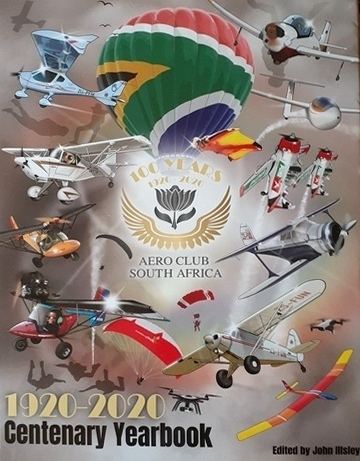



25
CANCELLED
Polokwane Airshow Contact: Noel Netshivhodza E-mail: netcoxm@gmail.com Cell: 081 728 0843
25
SAPFA Speed Rally at Middelburg airfield. Contact David le Roux e-mail: david@pilotinsure.co.za Cell: 073 338 5200
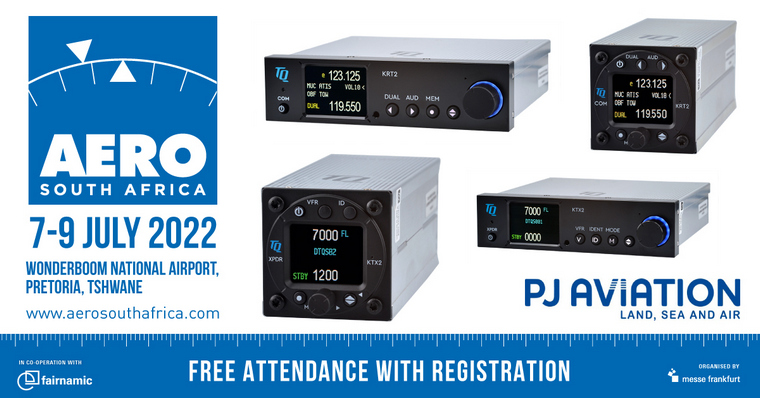

1 to 3
EAA Taildraggers at Warmbaths Airfield. Contact Richard E-mail: Richard.nicholson1963@gmail.com Cell: 082 490 6227
7 to 9
AERO South Africa at Wonderboom National Airport. Contact Annelie Reynolds E-mail: annelie.reynolds@za.messefrankfurt.com
16
SAPFA Kitty Hawk Rally. Contact Frank Eckard E-mail: frank.eckard@mweb.co.za Cell: 083 269 1516
16
Garden Route Airshow at George airport. Contact Brett Scheuble 084 418 3836
22 to 31
EAA AirVenture Oshkosh, Wisconsin, USA. Camping on the airfield contact Neil Bowden E-mail: neil1@telkomsa.net
29 and 30
Soutpansberg Fly-In Louis Trichardt.
Contact Jaco E-mail: spbvliegklub@gmail.com Cell: 082 353 6002
30
Krugersdorp Flying Club Spot Landing. Contact Nandi Tel: 083 577 8894 E-mail kfc@iafrica.com


26-27
Bethlehem Airshow at Bethlehem Airfield. Contact Stephan Fourie at E-mail: fouriesj1491@gmail.com Cell: 072 344 9678
26-28
Kuzuko Lodge RV fly-in safari in the Karoo. Contact Clive Gibson at E-mail: cagibson@global.co.za Website: www.kuzuko.com
.jpg)

SAAF GRIPENS STILL ON THE GROUND
defenceWeb
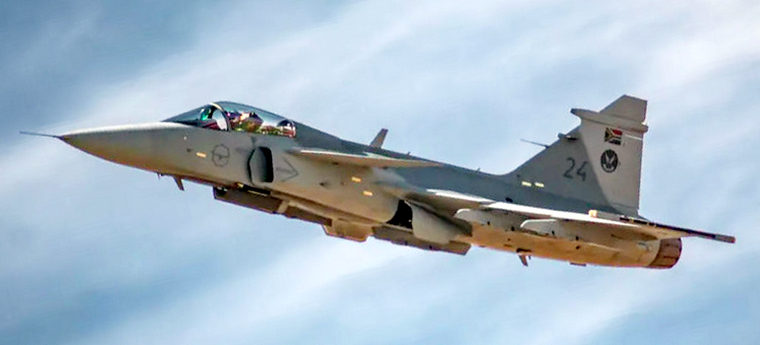
The sharp end of the SA Air Force (SAAF) - Air Force Base (AFB) Makhado-based 2 Squadron and its Saab Gripen fighters - has been dormant for more than six months with, as yet, no date known or set for the Swedish-built jet fighters to take to the sky with South Africans in the cockpit.
Making matters worse is the Gripen simulator is part and parcel of the not renewed maintenance and support contracts that Department of Defence (DoD) Head of Communication (HOC) Siphiwe Dlamini omitted to mention in his December statement advising the temporary grounding of South Africa's Gripen fleet.
The grounding was ascribed to a lack of funding along with maintenance and support contracts not being timeously renewed. defenceWeb, seeking an update on the Gripen status, was told by Brigadier-General Mongezi Kweta, Director SAAF Corporate Services, through the SA National Defence Force (SANDF) Directorate: Corporate Communication (DCC), the "latest" user requirement specification (URS) utilised during negotiations for the Gripen contract includes the simulator.
The one-star added "negotiation has been concluded" with "the process" in "the final phase awaiting final contract placement". He did not answer this publication's question on when a test flight can be expected.
The Gripens at AFB Makhado, also home to 85 Combat Flying School (CFS) and its Hawk Mk 120 lead-in fighter-trainers, is regarded as SAAF's "fighter town" and the Swedish-built jets, according to Kweta, have been maintained "even during times of not having a contract".
Flying, in his word's "flights", will resume "after final placement of the contract" and the ordering and delivery of "certain spares" is done.
On the issue of flying currency and instructor competency, Kweta said SAAF "processes and procedures" manage these aspects of flight operations, adding the "necessary control measures are applied when seamless transition is interrupted".
He did not respond when asked if Gripen instructors would retain competency by way of going to another country where Gripens were in service. The latest Department of Defence (DoD) annual performance plan (APP) notes an increase to R144 million from the previous figure of R66 million for training and development in the air defence programme. This increase, the APP states, is "largely due to currency training for pilots that is done overseas" without details of aircraft types or in which countries.

Kim Helfrich defenceWeb
The remaining handful of C-47TPs in service with 35 Squadron are in line for maintenance with Armscor seeking suitable suppliers of parts. The venerable C-47s have been in service with the SA Air Force (SAAF) since 1943 in configurations ranging from transport (cargo and passengers) to jump aircraft for Parabats, and maritime patrol and surveillance.
The upgrade to turbine from piston engines in 1994 was seen as a short term replacement in the maritime role following retirement of the Shackletons, military aviation enthusiast and historian Dean Wingrin told defenceWeb.
That no replacement platform for maritime patrol and surveillance was ever acquired means the remaining nine C-47TPs, with the TP suffix indicating "turbo prop", still fill that role to a certain extent today.
The limitations in maritime ability are made even more glaring when taking into consideration there are officially nine C-47TPs on the strength of 35 Squadron at Air Force Base (AFB) Ysterplaat with five "realistically available for use". Wingrin paints an even gloomier picture saying only one is presently operational but is undergoing servicing.
As to why Armscor, presumably at the request of the SAAF, is looking for parts, he is of the opinion it's because the maintenance budget of the C-47TP fleet is the lowest of all types in service with the airborne arm of the SA National Defence Force (SANDF).
"Given its lack of sophistication, with no offence to the aircraft or those flying and maintaining them, the C-47TP is generally regarded as a cheap aircraft to maintain. The engines are popular and in service worldwide in large numbers with spares easy to acquire. The avionics, civilian in standard, are ageing and require replacement/upgrade, but still maintainable. As the fleet of Dakotas internationally becomes smaller, accessing spares will be progressively more difficult and expensive to acquire," he told defenceWeb.
Taking what Wingrin calls "the dire financial situation" of the SAAF and the greater SANDF into account, he points out that there is no budget for acquisition - either new or previously operated - to fulfil the roles "intended" for the C-47TP.
"The SAAF has no option but to keep the C47-TP fleet in service for as long as possible."
In late May, Armscor issued a tender for "maintenance support for the Dakota C-47TP aircraft fleet".

defenceWeb
It appears the Angolan Air Force is taking delivery of another Ilyushin Il-76 transport aircraft as part of a batch of several additional airlifters. The Il-76TD, registration T-914, was spotted in Minsk, Belarus, earlier this month. Although painted in white, it was wearing Forca Aerea Nacional de Angola markings. On 9th June, the aircraft was tracked by FlightRadar24 over Egypt after departing Belarus on what is presumably its delivery flight.
It appears Angola may be acquiring several additional Il-76s. Il-76 registration T-912 was seen over Belarus in April and was first observed in February this year, indicating the first of a new batch: other Il-76TDs in Angolan service are T-908, T-909, T-910, and T-911, so based on the registrations, this indicates three additional aircraft are being delivered, possibly from ex-Belarussian stocks.
The Angolan Air Force has operated Il-76s for some 20 years. According to Scramble, only seven are currently operational, eight have been scrapped, and one is in storage. The type is flown by the Esquadra de Transportes which is based at Base Aérea No 1 (Luanda/4 de Fevereiro).
The Angolan Air Force relies mainly on An-12, An-24, An-72, C212 and Il-76 aircraft for its transport requirements. It recently acquired a couple of Xian MA60s from China and has ordered three C295s from Airbus. Although the latter order was first announced in 2018, it was only firmed up with Airbus in April this year. Two of the aircraft will be specifically equipped for maritime surveillance and one for transport missions.

SECOND BEECHCRAFT DENALI SUCCESSFULLY COMPLETES FIRST FLIGHT, EXPANDING FLIGHT TEST PROGRAM TO TWO AIRCRAFT
Textron Aviation today announced the successful first flight of its second Beechcraft Denali flight test article as momentum builds for the clean-sheet aircraft's certification program. The milestone flight follows the Denali prototype, which completed its first flight in November 2021.
The Beechcraft Denali is designed and manufactured by Textron Aviation Inc., a Textron Inc. (NYSE:TXT) company.
The second test aircraft joins the first Denali prototype in the important flight test program that substantiates the segment-leading performance expected of the Denali. The aircraft's flight lasted two hours and one minute, reaching a max altitude of 15,500 feet with a max speed of 240 knots. To date, the program has accumulated more than 250 flight hours.
"This flight is another vitally important step for the Beechcraft Denali program as the aircraft will be used primarily for testing aircraft systems like avionics, cabin environmental control and ice protection," said Chris Hearne, senior vice president, Engineering & Programs. "The team has made great progress, accomplishing key goals in the flight test program, and the Denali team heads into the second half of 2022 with a great deal of momentum."
The Denali flight test certification program is expected to eventually include a third flight test article and three full airframe ground test articles as it expands operational goals focusing on testing aircraft systems, engine, avionics and overall performance.

Recently at the UP.Summit, an annual gathering of leaders in transportation innovation hosted by investment firm UP.Partners, urban air mobility (UAM) pioneer Volocopter announced that it has achieved another milestone to bring UAM to life: its fixed-winged passenger aircraft, the VoloConnect, completed its first flight in May 2022.
This accomplishment makes Volocopter the only eVTOL (electric vertical take-off and landing aircraft) developer in the Western hemisphere to have an entire fleet of distinct aircraft configurations undergoing flight tests.*
Volocopter's third product solution, the VoloConnect, offers further and faster journeys than any other Volocopter aircraft to date, with a range of over 60 mi and flight speeds above 155 mph. The passenger plane's extended range and higher payload will bring business travellers and commuters beyond the city centre on routes like Burbank to Huntington Beach in Los Angeles, CA. With the VoloCity and VoloConnect air taxi designs fulfilling demands for metropolitan flights and suburban connections in densely populated regions respectively, Volocopter is ready to serve a broader range of passengers' flight needs. Moreover, the VoloConnect is targeting a 2026 entry into service, while the VoloCity is targeting commercial launch in 2024.
Volocopter designed the VoloConnect and its other eVTOL aircraft to meet the highest aviation safety standards according to EASA (European Aviation Safety Agency). The prototype completed its first flight in May 2022 after just 17 months in the making and performed a few manoeuvres for 2 minutes and 14 seconds during its first flight. The prototype has all the planned aerodynamics and performance features of the future commercial product.
The VoloConnect is a lift-and-cruise aircraft optimized for missions beyond the urban and suburban space. Keeping moving parts to a minimum, its six rotors facilitate vertical take-off, while two electric fans in combination with uplift-creating wings ensure high forward speeds. The VoloConnect prototype is currently being put through a demanding series of flight tests to verify that the aircraft and its systems are in line with the performance limits and prepared for the subsequent development steps. This phase encompasses a raft of different tests, including standardized low-speed, transition, high-speed, and engine failure testing for automated and later autonomous flights - all standard-issue tests for an eVTOL passenger aircraft manufacturer. Within the first three test flights of this campaign, the team was able to verify a significant portion of the eVTOL's envelope with forward speeds up to 40 mph and 28 mph sideward flight speeds during tests. The test flight envelope will be gradually opened as part of the test flight campaign over the coming weeks.
VoloConnect is poised to boost Volocopter's total addressable UAM market, alongside its existing aircraft family members, the VoloDrone and VoloCity. The technological differences between the VoloCity and VoloConnect passenger aircraft abound. Most important to note are their unique configuration designs for their specific flight missions, with the multirotor VoloCity air taxi poised to serve intra-city routes, while its larger lift-and-cruise sibling will focus on longer urban and suburban missions.
For future services, Volocopter intends to fully integrate all three aircraft into individualized UAM eco-systems for cities and use its VoloIQ digital platform to unite all of the company's flight operations, passenger services, maintenance, and more for a seamless mobility experience.

Veterans from the Vietnam War will be honoured as they travel to Washington D.C. to tour war memorials at no cost to them. The veterans will return to Oshkosh at the conclusion of the Friday afternoon air show and thousands of people will welcome them back home and give them the recognition they deserve.
"The Honour Flight is traditionally one of the most emotional and poignant events of AirVenture week," said Rick Larsen, EAA's vice president of communities and member programming. "We are proud to produce an event that honours what Vietnam veterans did for this country and be able to provide them with an experience of a lifetime."
American Airlines is donating the use of its Flagship Valor Airbus A321 aircraft for the flight, which is specially painted to recognize Medal of Honour recipients. The Honour Flight is flown by an all-volunteer crew of American Airlines pilots and cabin attendants.
"We're tremendously proud to be a part of this very special mission by providing Flagship Valor to get these heroes to Washington D.C.," said Randy Stillinger, manager of military and veterans initiatives for American Airlines. "With the help of our crew members, who have volunteered to fly this mission, we will recognize the service and sacrifice of these veterans by bringing them to the monuments built in their honour. Their brave actions allow us to fly freely all around the world, so this is the least we could do for them."
This is the eighth year that the Yellow Ribbon Honour Flight has originated at EAA AirVenture Oshkosh under the auspices of Old Glory Honour Flight of Appleton, Wisconsin. That non-profit organization has organized dozens of Honour Flights since 2009 with a dedicated group of volunteers. Those flights have included special flights to Pearl Harbour and to Vietnam.
"Each Old Glory Honour Flight mission is a special occasion, but the ability to be a part of EAA AirVenture for the first time since 2019 is a major part of this year's activities, "said Diane MacDonald, the executive director of Old Glory Honour Flight. "Honouring our local Vietnam veterans out of EAA AirVenture is such a highlight; being witness to the enthusiasm, respect, and appreciation from the world's aviation enthusiasts and when the flight returns to Oshkosh it is such an incredible sight to see that it means the world to the men and women who experienced it."

Staff Sgt. Max J. Daigle for 27th Special Operations Wing Public Affairs
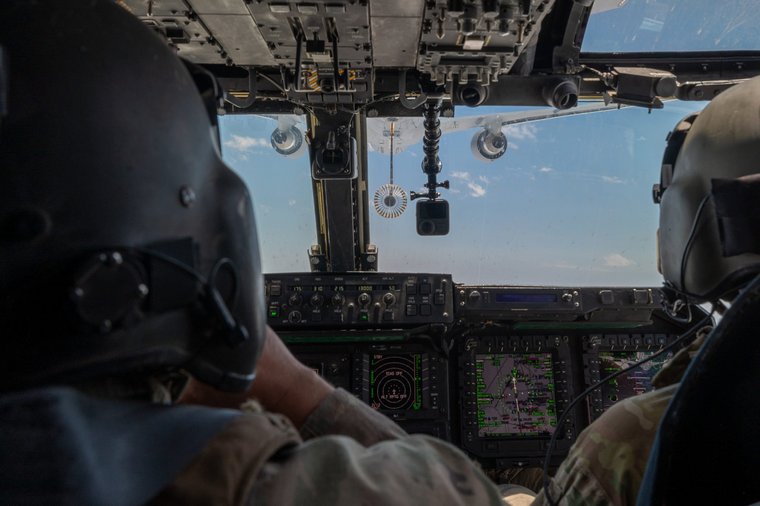
A CV-22 Osprey tiltrotor aircraft assigned to the 20th Special Operations Squadron and a KC-46 Pegasus tanker aircraft assigned to the 349th Air Refuelling Squadron conduct the first ever in-air refuelling operation between the two aircraft over Cannon Air Force Base, New Mexico.
Now, thanks to pathfinding efforts from the 20th Special Operations Squadron and the 349th Air Refuelling Squadron, assigned to the 22nd Air Refuelling Wing at McConnell Air Force Base, Kansas, CV-22 aircrews across Air Force Special Operations Command can ensure their aircraft's extended range by calling on Air Force Mobility Command's newest tanker.
The 20 SOS & 349 ARS brought a CV-22 and KC-46 Pegasus tanker together for in-air refuelling training over Cannon, June 1, 2022. The flight was the first time a KC-46 refuelled an AFSOC CV-22.
"This being the first time we operationally refuelled with a KC-46, we were able to get some good video for training and development," said Maj. Anthony Belviso, the CV-22 aircraft commander. "We were also able to get some understanding of what it feels like to fly behind the jet, and work on some different refuelling techniques and practices"
One of the new capabilities the KC-46 brings to the table is a hose and drogue system in the same centreline position as it's refuelling boom pipe for fixed-wing aircraft.
"This capability allows the KC-46 to the refuel the Osprey and other drogue compatible receiver aircraft without any modification," said Maj. Benjamin Chase, the KC-46 aircraft commander. "This is important because it enables flexibility in mission planning and limits the amount of maintenance it takes to prepare for air refuelling, especially compared to most aircraft in the legacy tanker fleet."
The KC-46 is not the only aircraft the CV-22 can receive fuel from while flying. However, its advanced refuelling, communications and defensive systems, range and large fuel storage capabilities make it an ideal system for getting CV-22s the fuel they need, even in or near contested environments.
"The CV-22 is specifically designed for long range missions, and when you add on top of that an aerial refuelling capability you can extend that distance to the point where you're only limited by how long the crew is able to fly," said Belviso. "The KC-46 can get enough fuel to get multiple CV-22s that much further both into and out of combat."
"The 22 ARW has showcased the capability of the KC-46 to operate out of austere locations in recent exercises," said Chase. "This is unique among tanker aircraft, and replicates the types of environments the KC-46 to operate out of when refuelling the Osprey in real-world missions."
Another advantage of CV-22s being able to refuel from KC-46s is that it allows for faster refuelling during real-world missions.
"Normally, an MC-130J aircraft would have to go up to a tanker to get fuel, then fly to us and give us that fuel, and would have to repeat that process several times," said Belviso. "Because KC-46s can refuel us directly, we can go straight to them and get everything done much more quickly."
With the successful training mission, both Chase and Belviso said it would provide the data and real-world experience the Air Force's KC-46 and CV-22 fleets need to ensure the two airframes could work well together for a long time to come.
"The refuelling of the CV-22 marks another success in the program," said Chase. "It really paves the way for support of the Osprey and other aircraft in the future."
"I'm glad we were able to get the mission done for the CV-22 community," said Belviso. "I think this new capability will be tremendous for us going forward, so I'm very happy about that."

With deliveries expected to start in 2026, the partnership will introduce the first eVTOL touristic flights from the Atlantis, The Palm in Dubai. Eve and Falcon will work together with the local stakeholders and authorities to support developing the Urban Air Mobility ("UAM") ecosystem for the United Arab Emirates ("UAE").
Captain Ramandeep Oberoi, Chief Operating Officer of Falcon, said: "We are ecstatic to partner with Eve and be the first operator of eVTOL in Dubai & the MENA region. The launch of this concept fully aligns with the Smart Dubai vision and will contribute to positioning Dubai as a global leader in sustainable Urban Air Mobility transportation. Falcon is actively engaged in Urban Air Mobility emergence and committed to delivering an effective and sustainable new urban transportation mode and providing the community with better and faster solutions. We are particularly proud to take a new step in the UAE, in a project that will be revolutionary for sustainable urban mobility."
"We are thrilled about partnering with Falcon and having the immense opportunity to enable the future urban mobility in the United Arab Emirates and launch eVTOL flights in Dubai. This is a massive challenge for both companies, which will help to position Dubai as a leader in the urban air mobility market. Eve's global experience, which spans different regions across the globe, will surely benefit the achievement of this project," said Andre Stein, co-CEO of Eve.
This collaboration re-enforces Eve's commitment and efforts to safely enable the global UAM ecosystem by providing an agnostic and holistic portfolio of solutions.

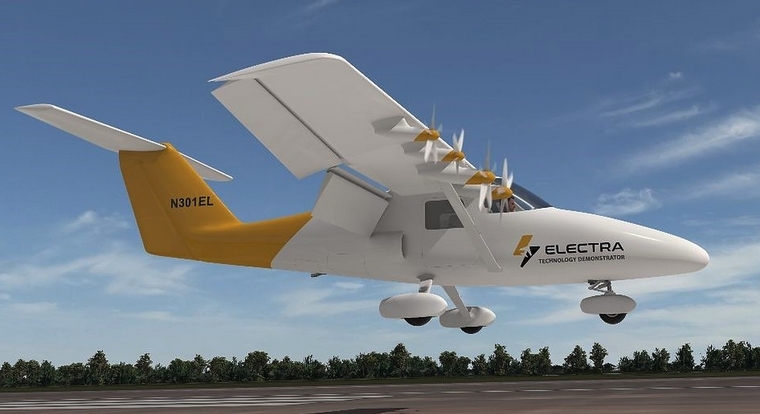
Both Electra and Airflow have been building blown-lift, ultra-short take-off and landing aircraft to serve new air mobility markets that favour the operating flexibility of a helicopter, yet require the superior range and economics of a fixed-wing aircraft.
With this acquisition, Electra is consolidating Airflow's eSTOL business under the Electra brand. Electra will integrate Airflow's highly experienced team, backlog of letters of intent and strategic partnerships into its own activities, which complement and strengthen Electra's portfolio and offer future customers more expansive and competitive options to meet future needs.
"The Airflow team and the Electra team both have deep experience in the development and testing of battery-powered aircraft. This experience convinced us that physics and the economics both strongly favour a solution that uses a wing throughout the full flight versus a rotor-borne vertical take-off and transition. Distributed electric propulsion allows us to take off and land within two vehicle lengths to access parking-lot sized spaces," said Marc Ausman, co-founder and CEO of Airflow. "This solution offers not only lower costs but a much more straightforward path to certification than vertical lift variants. We look forward to continuing our mission to develop such a vehicle as part of the Electra team."
Electra's quiet, low-emissions eSTOL aircraft is currently designed to transport nine passengers and a pilot or 1800 pounds of cargo up to 500 miles in all weather conditions. Electra's technology delivers 2.5x the payload and 10x longer range at 70% lower operating costs than vertical take-off alternatives.
"There are dozens of aspiring entrants in the AAM market. The acquisition of Airflow complements Electra's team, our sales pipeline, and technology portfolio which will allow customers to select the best solution to their needs in a rapidly expanding market," said John Langford, founder and CEO of Electra. "Marc Ausman is an incredibly talented individual, and the Airflow team is experienced and motivated, and share our mission and culture. This acquisition will allow Electra to grow and scale more quickly."
The acquisition places Electra's order book at almost 800 units, beyond break-even for commercial development. When used with sustainable aviation fuels (SAF), Electra's first-generation, hybrid-electric system offers a carbon-neutral aviation solution, burning a third less fuel than conventional aircraft. Airflow's strategic partnership with Plug Power (NASDAQ: PLUG) adds a next-generation, zero-emissions solution to Electra's portfolio.

Global eVTOL pioneer AutoFlight recently released the second, and latest, proof-of-concept (POC) video for its air taxi Prosperity I. The new video debuts less than four months after the original POC video and includes a modified, more efficient design of Prosperity I.
Prosperity I was designed for transfers between parts of a city, airport commutes, connecting two nearby cities or enabling trips to the countryside while avoiding traffic on the ground. When ready for commercial flight in 2026, it is expected that a trip that takes hours by car will be reduced to about 10 minutes with Prosperity I, without being any less safe or more expensive than a car taxi ride.
AutoFlight started building POC#2 from Jan 2022. The production took around 3 months, with the maiden flight in April, before achieving 30+ additional transition flights in the last few weeks.
Mark Henning, Managing Director of AutoFlight Europe said:
'POC#2 is a new milestone for us, and we are pleased to have achieved over 30 successful transitions in the last few weeks with a full-size aircraft. This further demonstrates the great potential of our lift & cruise configuration which combines simplicity and safety. We will encompass all these key experiences and learnings into the final, full scale, design of Prosperity I which we will be revealing later this year."
AutoFlight CEO Tian Yu, who has over two decades of experience designing and building electric aircraft, and 300 electric aviation-related patents, said:
"We're delighted to announce POC#2 for Prosperity I. This takes us another step towards our vision of unlocking the skies for mass individual transport in the air by creating safe, efficient eVTOL aircraft."
The milestone is the latest of a series of significant developments for AutoFlight including the establishment of a European base in Augsburg, the appointment of Mark Henning (formerly of Airbus) as its European Managing Director, as well as $100 million investment from next-generation mobility investor Team Global.

SOUTH AFRICA

On Saturday, 11th December 2021, a pilot and a passenger on-board a Bell 206L-3 helicopter with registration ZS-HXG took off from Ultimate Heliport in Midrand, Gauteng province, to their planned final destination in Plettenberg Bay, Western Cape province.
The pilot had planned to stop for refuelling at New Tempe Aerodrome (FATP) near Bloemfontein in the Free State province. An eyewitness (a pilot) who was at the helipad at the time the helicopter took off noticed smoke emanating from the right-side of the engine compartment and, thereafter, ran to a nearby helicopter that was parked on the helipad where he switched on the radio to establish communication with the pilot of the ZS-HXG helicopter to inform him of the smoke that was coming from the engine compartment.
After receiving the message from the eyewitness, the pilot executed a 180° turn to the helipad with the intention to perform a precautionary landing. A closed-circuit television (CCTV) camera positioned on the side of the Heliport building overlooking the helipads captured the helicopter entering an uncontrolled descent and crash-landing on the field just short of the Heliport's embarkment.
The helicopter was substantially damaged during the accident sequence. The pilot sustained minor injuries during the accident sequence whilst the passenger was not injured. Medical personnel at the Heliport administered first aid to the pilot before he was transported to hospital by ambulance. The pilot was admitted to the hospital for a few hours after being assessed but was later discharged.
The investigation revealed that an engine oil pressure hose became damaged after coming into contact with the rotating rotor brake disk. This caused oil starvation to the engine and thermal destruction of the Number 6 and 7 bearings, as well as the decoupling of the spline (tie bolt) coupling from the compressor drive shaft. The clash of rotating components as the shaft separated caused the turbine wheel to burst.
The helicopter experienced an engine failure and landed hard just short of the helipad's embankment. The engine failure was due to insufficient oil being supplied to the engine as a result of a damaged engine oil pressure supply hose, causing the Number 6 and 7 bearings to suffer thermal destruction which led to an internal clash of rotating components, followed by the destruction of the 1st stage gas producer turbine.
• Poor maintenance practise as the engine oil hose was not correctly secured to the required P-clamps as called for in the maintenance manual.
• Non-compliance with regards to the safe standard and recommended practises from the manufacturer as well as the Civil Aviation Regulations (CAR) 2011 as amended.

Switzerland, Epagny-Gruyères Airfield, FR: A Swiss Helicopter AG Guimbal Cabri G2 with two occupants suffered a technical malfunction and crashed after take-off at Epagny-Gruyères Airfield (LSGT), Fribourg. Both occupants sustained minor injuries and the helicopter received substantial damage.

USA, Chicago-O'Hare International Airport, IL: A Hyannis Air Service Inc dba Cape Air Tecnam P2012 Traveller encountered jet blast while taxiing for departure. It sustained damage to wingtip from striking taxiway.
USA, Bruce Campbell Field Airport, Madison, MS: A Bellanca 17-30A Super Viking 300A with two on board was substantially damaged when it was involved in an accident in Madison, Mississippi. There were no injuries.

USA, near University Airport, Davis, CA: A Cessna TR182 Turbo Skylane RG was consumed by fire following an inflight fire and subsequent forced landing on farm field terrain shortly after take-off from University Airport (EDU/KEDU), Davis, California. The sole pilot onboard the airplane received minor injuries.
USA, Weslaco, TX: A Meyers 200A crashed in Weslaco, near Mid Valley Airport (KTXW), Texas. The pilot sustained minor injuries and the aircraft received substantial damage.

USA, Lady Bird Lake (Colorado River), Austin, TX: A Texas Parks and Wildlife Department Cessna T206H Stationair TC experienced mechanical issues and crashed in Lady Bird Lake, (Colorado River) Austin, Texas. The pilot reported smoke in the cockpit and loss of engine power. The Texas Parks and Wildlife Game Warden pilot received serious injuries.
Afghanistan, Panjshir: An Afghanistan Air Force Mil Mi-17V-5 with seven on board force landed during a test flight, after which it was set on fire by anti-Taliban rebels.


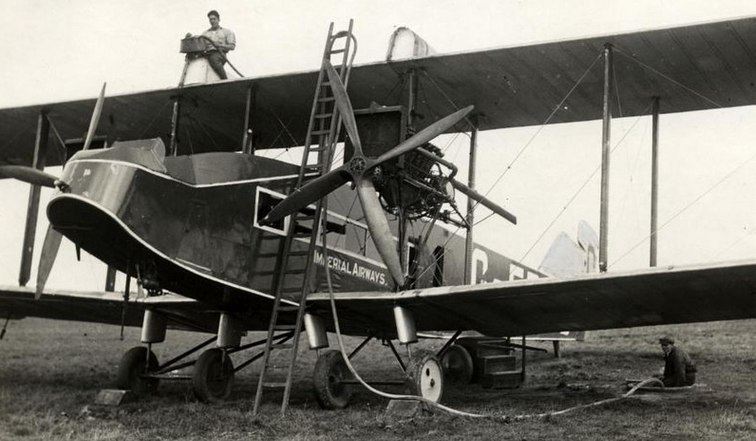
14 JUNE 1929
In efforts to encourage passenger traffic for their expanding international air routes, British Imperial Airways makes the first 30-minute "tea" flight over London, costing £2 2s, reduced 1931 to £1 10s.
Imperial Airways was the early British commercial long-range airline, operating from 1924 to 1939 and principally serving the British Empire routes to South Africa, India, Australia and the Far East, including Malaya and Hong Kong. Passengers were typically businessmen or colonial administrators. Most flights carried about 20 passengers or less. Accidents were frequent: in the first six years, 32 people died in seven incidents.

Google Banner Ad

 |
 |
 Copyright © 2024 Pilot's Post PTY Ltd
The information, views and opinions by the authors contributing to Pilot’s Post are not necessarily those of the editor or other writers at Pilot’s Post.
Copyright © 2024 Pilot's Post PTY Ltd
The information, views and opinions by the authors contributing to Pilot’s Post are not necessarily those of the editor or other writers at Pilot’s Post.